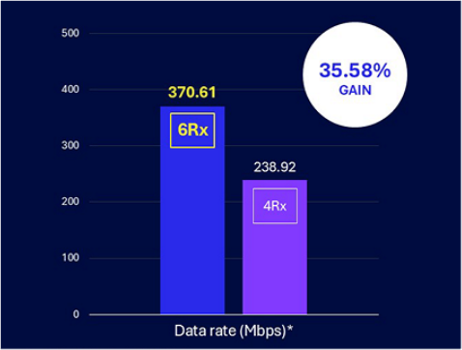09
Oct
Improving 5G smartphone performance with 6Rx and AI

-
In wireless communications, multiple antennas typically results in improved performance
-
Fitting more antennas within the constraints of a smartphone and managing them is a major challenge
-
A new feature called 6Rx will allow up to six antennas per phone
In wireless communications, the use of multiple antennas typically results in improved performance. However, fitting more antennas within the constraints of a smartphone and managing them is a major challenge. That’s why today’s smartphones typically have only two or four antennas. But a new feature called 6Rx will allow up to six antennas per phone. Additionally, the on-device AI intelligently manages these antennas to maximize performance and optimize power consumption and battery life. The cellular modem supporting these features was introduced last year, followed by the announcement of a smartphone this year.
The primary benefit of 6Rx is a significant improvement in downlink cell-edge speeds and user experience. This effectively closes the 5G coverage gap (compared to 4G) created by the mid-band spectrum utilized by most operators. Additionally, 6Rx enhances overall capacity and uplink performance. Moreover, this feature doesn’t require any standards changes or upgrades to the network infrastructure, making it a cost-effective and fast time-to-market feature for 5G operators.
5G performance needs
The rapid proliferation of 5G, the popularity of true unlimited data plans, and the unprecedented growth of fixed wireless access (FWA) are quickly depleting the available capacity in today’s 5G networks. Operators are seeking cost-effective ways to enhance the capacity and performance of their existing networks without requiring significant infrastructure investments.
Most operators utilize midband spectrum (e.g., 3.5 GHz) for 5G. However, the underlying networks are built on 1800 NHz, 1900 MHz, or 2.1 GHz 4G site grids. Since higher frequencies have a smaller coverage footprint, this difference in frequency between 4G and 5G creates coverage gaps. Much of these gaps are addressed by 5G’s massive MIMO, which can support up to 64 antennas on base stations (64T64R). However, massive MIMO may not be beneficial in improving performance at the edges of cells, in hard-to-reach areas such as indoors, basements, and urban jungles. Weak signal is one of the consistent customer complaints of 5G. The current solutions, such as small cells and network densification, are very expensive and time-consuming.
In such a condition, 6Rx is an ideal solution to this challenge that 5G operators are facing today.
What is 6Rx?
As the name suggests, this feature utilizes six receive antennas, instead of the typical four, in 5G devices. More antennas mean better diversity gain and coverage. But keeping all antennas active all the time significantly increases power consumption and reduces battery life. Therefore, the smart approach is to use only as many as needed to maximize coverage, neither more nor less.
You might ask, “What is the big deal here? FWA CPEs have as high as 8Rx configuration!” The primary difference lies in the constrained space and battery life requirements of smartphones. Each of these antennas will have a complete receive chain, comprising of low-noise amplifiers (LNA), filters, mixers, analog-to-digital converters (ADC), and digital signal processors (DSPs). Fitting all of them for all antennas into a small smartphone form factor with sufficient isolation and diversity gain is a Herculean effort. It requires deep technology expertise and experience.
Managing these antennas is another major hurdle. RF conditions change extremely rapidly. The decision of how many and which antennas to use must be made in almost real-time. That’s exactly where on-device AI comes into play. AI algorithms determine how many and which antennas to use, based on the type of traffic (best effort or latency-sensitive), spectrum, signal conditions, near-end obstructions (e.g., hand or head blocking), antenna performance, and other relevant parameters.
Qualcomm was first introduced to 6Rx in its Snapdragon X80 5G modem in 2024. Following that, the company announced its second-generation solution, Snapdragon X85 5G, during MWC Barcelona 2025, which further enhances performance. Xiaomi was the first Smartphone OEM to adopt 6Rx, and many others are keenly interested in it.
Since 6Rx is a proprietary technology that does not require standards or changes to the network, vendors have the full flexibility to optimize their designs and AI algorithms, offering highly differentiated solutions.
Performance improvements with 6Rx
The user’s perception of network coverage and experience is often determined by the performance at the cell edges. Studies have shown that 6Rx can increase the cell-edge data rates by 20% or more. For users, that means being able to make voice calls where it was previously impossible, enjoying stutter-free video streaming, a more immersive gaming experience, and improved performance of lower-latency applications.
Additionally, 6Rx can increase the overall network capacity by up to 20%. This is because more antennas enable smartphones to achieve better signal quality and minimize interference. Both will increase overall user data rates and, thereby, the network capacity.
Qualcomm’s field tests, utilizing smartphones with their latest X85 5G modem, have shown that overall user speeds can be as high as 35%. Currently, Qualcomm is the only provider that supports this feature in 5G modems.


0 comments